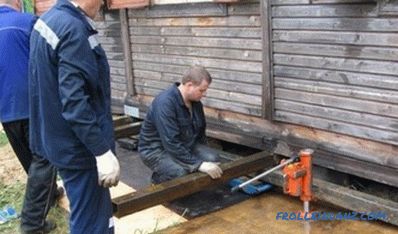Wood has long been used as a building material. Yet no development has been able to surpass it in environmental performance and quality insulation. But it is impossible to perfectly choose the form of the components, if the building is erected from a log house. In addition, the material shrinks and shrinks, which leads to a change in its configuration. At a certain stage, the need to seal the seams in wooden houses.
Why this is necessary
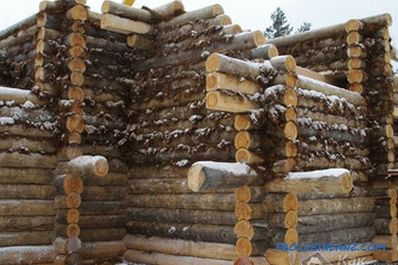 Moss was used in the construction of the house
Moss was used in the construction of the house
Late processing of slots can be a big problem for those who live in the house. Due to leaks, drafts occur that inevitably lead to poor health. In addition, the accumulated heat is weathered. With current prices for coolants, this will translate into a good penny. It is also harmful for the logs themselves. With the constant penetration of moisture, the wood may start to rot, which will lead to the formation of fungus and then large-scale repair will be required. There is a lot of talk about what is the best way to seal the seams: with natural materials or synthetic sealant.
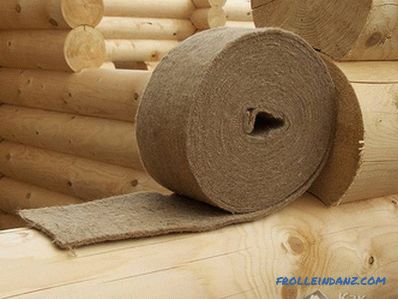 Intermediate insulation - jute canvas
Intermediate insulation - jute canvas
In fact, one does not exclude the other. At the stage of construction of the house from the bar is the primary caulker. Traditional materials are used for it: tow, moss or modern tape materials on a natural basis. It improves the docking of logs, and also speeds up the construction process. After half a year of operation or a little more, a re-caulking iron will be required (some builders instead will immediately apply sealant treatment), which is carried out using the same materials. It will already serve as a basis for complete sealing of the seams.
Why sealant
 Sealant
Sealant
Modern does not mean bad. Sometimes poorly performed work is explained by the fact that there is a lack of knowledge about how to properly use certain materials. The advantages of the sealant are:
- High elasticity. Logs - a living building material. In the process of changing temperature and weather conditions, both expansion and contraction of the bars can occur. Sealant can compensate for these fluctuations. On stretching it can withstand 200% of the original size.
- Good adhesion. This material is water based. It interacts well with the tree, penetrating into the pores and associating with it. This ensures excellent tightness.
- Easy application. To use this method, there is no need for special training. There will be enough skill that is acquired in the process.
- No need for complex tools. Most of what you need is already at home for everyone, and extras are sold at any hardware store.
- Easy color matching. Even if your frame was painted, it would not be a problem to choose a sealant to match.
- Relevance for different climatic zones. The range of maintained temperatures ranges from -50˚ C to + 70˚ C.
- High speed of work. If you use a pneumatic gun, then the end result for a large building can be achieved in one or two weeks.
- Seal protection. Natural fibers are a favorite building material of birds, which they apply to their nests. Sealant simply closes their access.
- Vapor permeability. High quality mixtures do not prevent the removal of moisture, which is necessary to preserve the microclimate.
- Antiseptic properties and protection from insects. The compactor simply prevents pests from entering the crevices.
- Possibility of repair work if the seam was damaged.
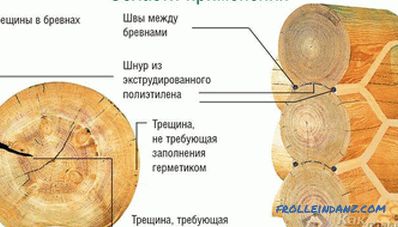 Warm joint
Warm joint
It may be tempting to seal the interwall space with polyurethane polyurethane foam or ordinary silicone. It is absolutely not recommended to do this. Under the influence of various weather conditions in a few months this material will fall out by itself, and everything will have to be started over. The funds will go down the drain.
Required Tools
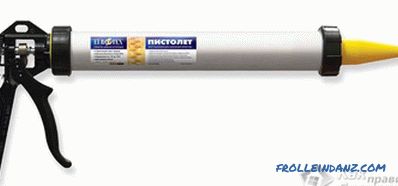 Gun for Suture Sealant
Gun for Suture Sealant
In order In order to realize a warm joint in a wooden house, we need the following components:
- Sealant. To calculate its quantity, it is necessary to approximately imagine how thick and wide the seam will be. Further, the area of its cross section is calculated; for this, the width is multiplied by the length. After the volume of one tube is divided into this area. So we will know how many meters it will be enough. We change the length of all seams and divide by the number of meters from one tube.
- Electric, pneumatic or manual gun for applying sealant.
- Spatula.In this case, a small tool is used, which is similar to the one that is used when laying bricks for jointing.
- A bucket of water. Since most sealants are water-based, they can be easily washed with it.
- Rags. Rags will be necessary for us to clean the spatula and remove stains.
- Spray bottle.
There are some types of sealing material that are already immediately available in blanks for seams. For their application does not need a gun. They are laid in the slots, rolled by a narrow roller, after which the film is removed.
Work steps
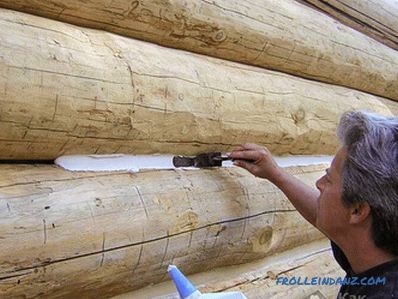 The process of making a warm joint
The process of making a warm joint
For for sealing tasks, it is better to choose calm and dry weather. The procedure will be as follows:
- If the house or bath has not yet been treated with an antiseptic, then it should start with that.
- Select the side of the building, which is in the shade in the first half of the day. This is very important, because when applied it is undesirable to drop in direct sunlight. If you do not comply with this requirement, the moisture will evaporate too quickly and cracks will form in the form of cobwebs, which not only spoil the appearance, but also worsen the result.
- With a soft brush, dust is removed from the intergap space. If there is a worn natural insulation, then it should also be eliminated.
- With a spray bottle, ordinary water is sprayed onto the treatment area. This is necessary to increase the adhesion of the applied mastic and wood. It also compensates for the lack of moisture. When the logs are too dry, they will pull the liquid out of the sealant, which will cause cracking.
- The gun is filled with sealing material. The tool nose is cut at an angle of 45˚. So it will be easier to create a seam of the correct form.
- Apply sealant. It is necessary to move the gun with the same speed so that the material thickness at all points is the same. When applying, you must comply with the rule 2/3, i.e. the thickness of the seam must be not less than 2/3 of its height. It is this proportion that will allow it to be strong enough and not to tear when further shrinkage occurs. In the case when the gap is large enough, inside it is necessary to lay a special cord of polyethylene foam.
- The next step is to align the line with a trowel. To do this, it needs to be wetted in water and with gentle movements without much effort to bring out a beautiful plane.
- All drips are gently removed with a damp cloth.
- In order to quickly fill your hand, you need to start with straight sections and at the end make cuts.
- In the first few hours it is necessary to protect the surface from precipitation, because the rain will simply wash away everything that has been done.
- After the mastic has completely dried, it can be coated on top with a clear acrylic varnish. It will serve as additional protection and will not affect the selected color.
- It is better to start outside, and then repeat the same actions inside.
- Indoors it is possible to decorate embedded slots with a rope.
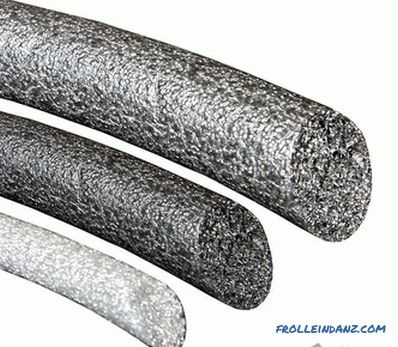 Foam polyethylene cord
Foam polyethylene cord
In order to facilitate your work applying mastic, some masters recommend the use of masking tape. It is glued to the upper and lower timber so as to limit the space of the sealant. After the completion of the work, it can be removed and the surface will remain without drips.
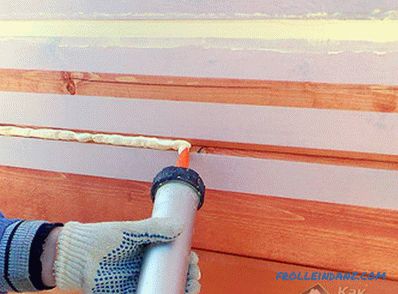 Sealing of the joints
Sealing of the joints
In this simple way, the joints are sealed in a wooden house. If you have enough time, then you can easily handle all the work yourself.
Video
How to seal the seams using the "warm seam" technology, see below:
See also:
Log caulking tools



